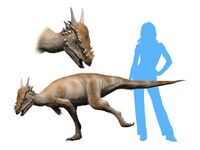Earth:Ferris Formation
| Ferris Formation Stratigraphic range: Maastrichtian-Danian ~66–63 Ma | |
|---|---|
| Type | Geological formation |
| Underlies | Hanna Formation |
| Overlies | Medicine Bow Formation |
| Thickness | 600–2,000 m (2,000–6,600 ft) |
| Lithology | |
| Primary | Mudstone |
| Other | Sandstone |
| Location | |
| Coordinates | [ ⚑ ] : 41°48′N 106°36′W / 41.8°N 106.6°W |
| Paleocoordinates | [ ⚑ ] 48°48′N 82°12′W / 48.8°N 82.2°W |
| Region | |
| Country | |
| Extent | Hanna Basin |
| Lua error in Module:Location_map/multi at line 27: Unable to find the specified location map definition: "Module:Location map/data/Wyoming" does not exist. | |
The Ferris Formation is a Late Cretaceous (~66 Ma) to Paleocene (66-63 Ma), fluvial-deltaic geological formation in southern Wyoming. It contains a variety of trace and body fossils, preserved in sandy fluvial channel deposits and overbank units. Dinosaur remains are fragmentary, but include Triceratops, Tyrannosaurus, dromaeosaurids, Paronychodon, Ricardoestesia, Edmontosaurus, Edmontonia, Ankylosaurus, and Pachycephalosaurus.[1]
Some of the fluvial channels contain evidence of tidal influence and brackish water, in the form of tidal facies, shark teeth, and shrimp burrows. This demonstrates that the western shoreline of the Western Interior Sea was still within a few hundred kilometers even during the latest Cretaceous. The local K-T boundary is contained within a sandy channel deposit made up of stacked bars. Reworked Cretaceous fossils are preserved at the base of the channel complex, associated with mud rip-up clasts, and Paleocene mammal fossils are preserved in the upper portion of the bar.[2]
The Ferris Formation is up to 2,000 metres (6,600 ft) thick in the Hanna Basin and represents a rapid accumulation of predominantly fine-grained sediment on a broad delta. The delta previously fed the deepwater Lewis Shale and shallow marine Fox Hills Formation. The Ferris followed behind as a system of lagoons, bays, and delta plain environments.
Vertebrate paleofauna
In addition to a variety of dinosaurs, the following taxa are known from the Ferris Formation:
- Myledaphus
- Lissodus
- Cretorectolobus
- Phylodus
- Amia
- Lepisosteus
- Basilemys
- Adocus
- Leptochamops
- Brachychampsa
and a variety of Cretaceous and Paleocene multituberculates, marsupial, and placentals.
Ornithischians
| Ornithischians of the Ferris Formation | ||||||
|---|---|---|---|---|---|---|
| Genus | Species | Location | Stratigraphic position | Abundance | Notes | Images |
| Ankylosaurus[3] | Indeterminate[3] | |||||
| Nodosauridae[4] | Indeterminate[3] | |||||
| Stygimoloch[3] | S. spinifer[3] | |||||
| Thescelosaurus[3] | Indeterminate[3] | |||||
| Triceratops[3] | Indeterminate[3] | Ferris remains previously attributed to Triceratops have been subsequently identified as indeterminate chasmosaurine fossils[3] | ||||
Saurischians
| Saurischians of the Ferris Formation | ||||||
|---|---|---|---|---|---|---|
| Genus | Species | Location | Stratigraphic position | Abundance | Notes | Images |
| Ornithomimus[5] | O. sp.[5] | |||||
| Tyrannosaurus[3] | T. rex[3] | |||||
See also
- List of dinosaur-bearing rock formations
- Hell Creek Formation
- Fort Union Formation
References
- ↑ Wroblewski, 1995
- ↑ Lillegraven & Eberle, 1999
- ↑ Jump up to: 3.00 3.01 3.02 3.03 3.04 3.05 3.06 3.07 3.08 3.09 3.10 3.11 "3.12 Wyoming, United States; 9. Ferris Formation," in Weishampel et al., 2004, p.585
- ↑ Listed as "Edmontonia cf. rugosidens" in "3.12 Wyoming, United States; 9. Ferris Formation," in Weishampel et al., 2004, p.585
- ↑ Jump up to: 5.0 5.1 Listed as "Ornithomimus cf. velox" in "3.12 Wyoming, United States; 9. Ferris Formation," in Weishampel et al., 2004, p.585
Bibliography
- Weishampel, David B.; Peter Dodson, and Halszka Osmólska (eds.). 2004. The Dinosauria, 2nd edition, 1–880. Berkeley: University of California Press. Accessed 2019-02-21. ISBN:0-520-24209-2
- Wroblewski, Anton F.. 1995. First report of changes in lower vertebrate faunas across the Cretaceous-Tertiary boundary, western Hanna Basin, Wyoming. Journal of Vertebrate Paleontology Supp. to volume 15. 61A.
- Lillegraven, Jason A., and Jaelyn J. Eberle. 1999. Vertebrate Faunal Changes through Lancian and Puercan Time in Southern Wyoming. Journal of Paleontology 73. 691–710. Accessed 2020-11-16.
 |






